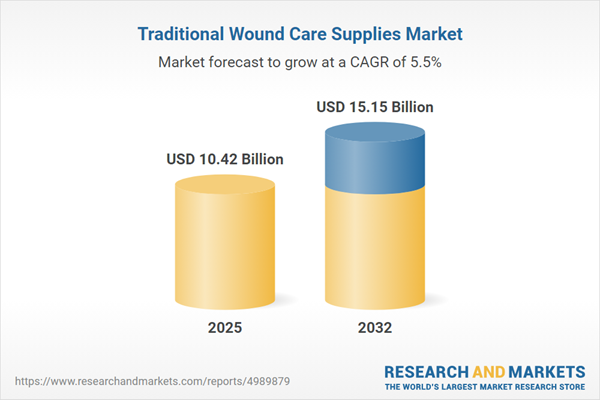Speak directly to the analyst to clarify any post sales queries you may have.
The traditional wound care supplies market is experiencing rapid transformation, driven by evolving clinical needs, regulatory shifts, technology integration, and supply chain adaptation. As digital care and innovative materials become more prominent, market participants will need robust strategies to remain competitive in diverse healthcare environments.
Market Snapshot: Steady Growth and Strategic Significance
The traditional wound care supplies market grew from USD 9.88 billion in 2024 to USD 10.42 billion in 2025. It is expected to expand at a CAGR of 5.48%, reaching USD 15.15 billion by 2032.
This steady growth is supported by increased demand from an aging population, the rising incidence of chronic wounds, and the ongoing shift toward outpatient and home-based care.Scope & Segmentation
- Product Types: Bandages, including adhesive, elastic, and non-woven options • Dressings such as alginate, collagen, film, foam, hydrocolloid, and hydrogel formulations • Wound care devices, including compression systems, negative pressure wound therapy, and irrigation tools
- Wound Types: Acute (abrasions, incisions, lacerations, punctures) • Burns (first, second, third degree) • Chronic wounds (diabetic foot ulcers, pressure ulcers, venous leg ulcers) • Surgical wounds (emergency, major, minor procedures)
- End Users: Ambulatory care centers • Clinics • Home healthcare • Hospitals
- Distribution Channels: E-commerce • Hospital procurement • Retail pharmacies • Wholesale distributors
- Regions Analyzed: Americas (including United States, Canada, Mexico, Brazil, Argentina, Chile, Colombia, Peru) • Europe, Middle East & Africa (including UK, Germany, France, Russia, Italy, Spain, Netherlands, Sweden, Poland, Switzerland, UAE, Saudi Arabia, Qatar, Turkey, Israel, South Africa, Nigeria, Egypt, Kenya) • Asia-Pacific (China, India, Japan, Australia, South Korea, Indonesia, Thailand, Malaysia, Singapore, Taiwan)
- Leading Companies Profiled: 3M Company • Johnson & Johnson • Smith & Nephew plc • ConvaTec Group plc • Mölnlycke Health Care AB • Coloplast A/S • Essity AB • Cardinal Health, Inc. • Integra LifeSciences Holdings Corporation • Medline Industries, L.P.
Key Takeaways: Strategic Insights Driving Opportunity
- Demographic shifts—particularly aging populations and the increased prevalence of chronic conditions—are accelerating demand for innovative wound care supplies across all regions.
- Integration of digital platforms and telehealth enhances wound monitoring and post-discharge care, supporting better patient adherence and faster response to complications.
- Suppliers are adopting sustainable materials and packaging, prompted by heightened regulations and end user interest in environmental impact reduction.
- The supply chain has been reengineered, with more manufacturers utilizing vendor-managed inventory models and e-procurement to reduce the risk of stockouts and streamline fulfillment in complex healthcare systems.
- Decentralization of care from hospitals to outpatient and home settings increases demand for user-friendly products and education-focused solutions that support non-clinical caregivers.
- Collaborations between industry leaders, academic institutions, and digital partners are advancing product portfolios, extending reach, and facilitating faster commercialization of new wound care technologies.
Tariff Impact and Supply Chain Resilience
Recent adjustments to United States tariff schedules have increased the cost of certain raw materials and components essential for traditional wound care supplies. Stakeholders are implementing nearshoring, inventory and supplier diversification, and flexible contracting to minimize disruptions while maintaining pricing strategies and service continuity. Greater transparency in tariff classification and value chain management is becoming a priority across the industry.
Methodology & Data Sources
The report applies a comprehensive approach, combining desk research of clinical guidelines, regulatory filings, trade sources, and product data with independent interviews from procurement, clinical, and product stakeholders. Findings were cross-validated through stakeholder surveys, multiple peer reviews, and strict quality control processes to maintain integrity and impartiality.
Why This Report Matters
- Offers actionable intelligence for procurement and C-suite leaders seeking to adapt to regulatory shifts, evolving care models, and supply chain challenges in the traditional wound care supplies sector.
- Empowers stakeholders to benchmark competitors, pinpoint emerging technology opportunities, and align business development strategies in diverse regional markets.
Conclusion
For decision-makers in the traditional wound care supplies market, the path forward centers on agile product innovation, supply chain optimization, and collaborative approaches that respond to new care delivery models and regional demands.
Additional Product Information:
- Purchase of this report includes 1 year online access with quarterly updates.
- This report can be updated on request. Please contact our Customer Experience team using the Ask a Question widget on our website.
Table of Contents
3. Executive Summary
4. Market Overview
7. Cumulative Impact of Artificial Intelligence 2025
Companies Mentioned
The companies profiled in this Traditional Wound Care Supplies market report include:- 3M Company
- Johnson & Johnson
- Smith & Nephew plc
- ConvaTec Group plc
- Mölnlycke Health Care AB
- Coloplast A/S
- Essity AB
- Cardinal Health, Inc.
- Integra LifeSciences Holdings Corporation
- Medline Industries, L.P.
Table Information
| Report Attribute | Details |
|---|---|
| No. of Pages | 196 |
| Published | November 2025 |
| Forecast Period | 2025 - 2032 |
| Estimated Market Value ( USD | $ 10.42 Billion |
| Forecasted Market Value ( USD | $ 15.15 Billion |
| Compound Annual Growth Rate | 5.4% |
| Regions Covered | Global |
| No. of Companies Mentioned | 11 |









